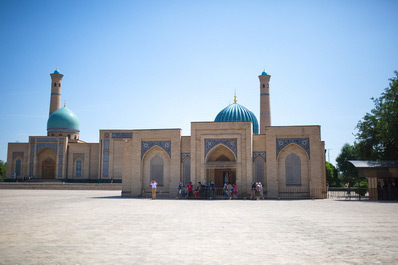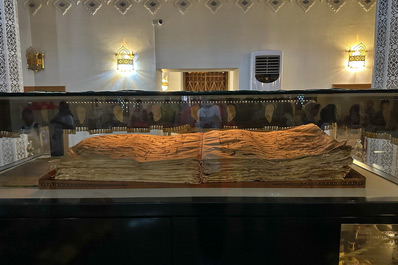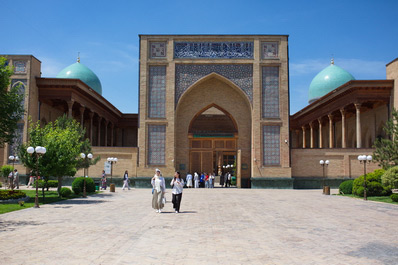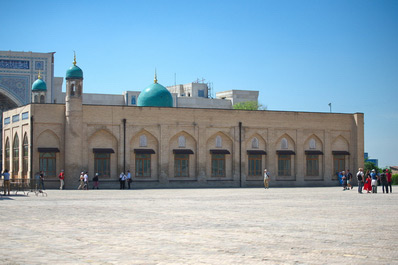Hazrati Imam Ensemble, Tashkent

Hazrati Imam, also known as Hast Imam, is one of the most significant architectural monuments in Tashkent. The complex was established at the burial site of one of the first Tashkent imams, Hazrati Imam, also known as Abu Bakr Muhammad Kaffal Shashi. He was a Quran expert, poet, and craftsman who visited many spiritual centers of the Islamic world. Hazrati Imam studied in Syria, Iran, and Iraq, made a pilgrimage to Mecca (Hajj), and spread the teachings of one of the legal schools of Sunni Islam.
The ensemble includes the Muyi Muborak Madrassah, the Mausoleum of Hazrati Imam, the Namazgoh Mosque, the Imam Al Bukhari Islamic Institute, the Barak Khan Madrassah, the Hazrati Imam Cathedral Mosque, and the Tilla Sheikh Mosque. Each of these architectural creations is a masterpiece of oriental architecture from different epochs, featuring both modern constructions and buildings from the 16th to 19th centuries.
The Muyi Muborak Madrassah (Museum of the Holy Quran) is one of the oldest buildings in the complex. It houses a true treasure - the Holy Quran, written in Kufic script on deer skin. There were originally six copies of this Quran in the world, but only four have survived. Other copies are in England, Cairo, and Turkey, and the one kept in Tashkent is the best preserved. The Quran in the Muyi Muborak Madrassah is the final, canonized version of the Holy Book, completed during the reign of Caliph Uthman ibn Affan, who was one of the companions of the Prophet Muhammad. This ancient manuscript consists of 353 massive sheets sewn into a single giant talmud. Legend has it that Caliph Uthman was killed while reading this Quran, and several pages were stained with his blood. Additionally, the madrassah is said to house a golden hair of the Prophet Muhammad.
The Muyi Muborak Madrassah was built in the 16th century and has been rebuilt many times over the centuries, changing its purpose. Initially, it was used by students studying the Quran. Later, it served as a shelter for dervishes, members of the Sufi brotherhood, and in 1857, it housed a large library with thousands of books and ancient manuscripts. During modern times, a separate building was constructed next to the madrassah to house the book collection. The rich collection of manuscripts and printed publications includes more than 20,000 scrolls, albums, almanacs, and folios, including translations of the Quran into 30 languages.
The Mausoleum of Hazrati Imam was built in 1541-1542 by architect Gulyam Hussain over the imam's tomb. The tomb is an asymmetrical domed portal mausoleum. The chamber housing the sarcophagus has an arch to ensure that everyone entering bows before the relics of the great Islamic preacher. The walls of the mausoleum are decorated with carved panels, and the dome is covered with colored tiles.
The Namazgoh Mosque, built in 1865, is another important part of the Hazrati Imam complex. During the 1917 revolution, the mosque was looted and destroyed, and its restoration became possible only 60 years later. In the Soviet years, the mosque's interior was divided by partitions, and a dormitory was housed within its surviving walls. The Namazgoh Mosque features a blue dome and a long arched gallery with an open wooden terrace. In 1971, the Islamic Institute named after Imam Al Bukhari was built next to the mosque. It was the first and only higher educational institution in the USSR where Islam was studied. Today, the institute trains specialists in Islamic studies, Arabic language teachers, and high-ranking clerics (imams). In addition to religion and languages, students study calligraphy, political science, philosophy, the history of Uzbekistan, ecology, and public speaking. The institute's conference hall and library are located within the mosque's walls, though the mosque building itself is not currently used for services and prayers.





